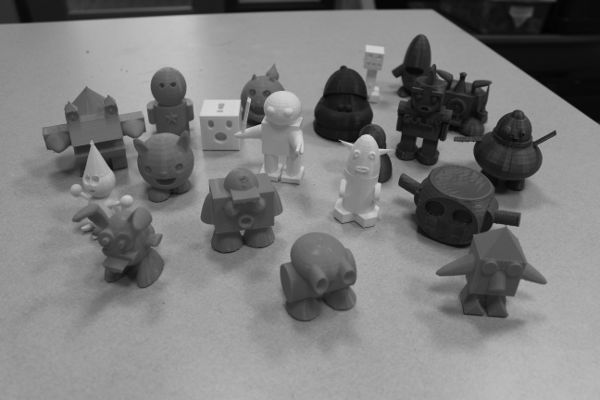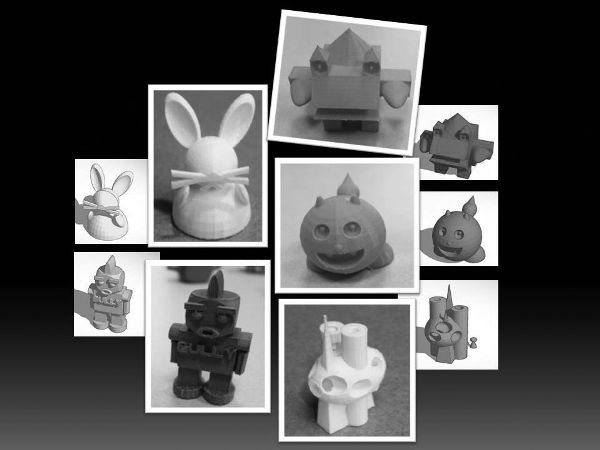59
3D Print Characters for Stop-Motion Films
MICHAEL CHERRY / TEEN AND YOUTH LIBRARIAN
Evansville Vanderburgh Public Library
Type of Library Best Suited for: School or Public
Cost Estimate: $5,000–$10,000 for all supplies and equipment
Makerspace Necessary? No
PROJECT DESCRIPTION
During the summer months, the Evansville Vanderburgh Public Library hosts a 3D Printing and Film Camp at their Central Library. Students attending the camp learn how 3D printing is influencing the Hollywood film industry. They discover how animated films like Coraline, The Boxtrolls, ParaNorman, and Kubo and the Two Strings utilize 3D printing in the creation of stop-motion characters. Stop motion is an animation technique in which you move a physical object that you’re filming very slightly between frames to make it appear to be moving independently.
Additionally, they learn how 3D printing is used for costume and prop fabrication in films like Star Wars: The Force Awakens and Batman vs. Superman: Dawn of Justice, among others. The camp is geared towards middle school and high school students. In addition to learning about these films, students design and 3D print a character or small prop for a stop-motion movie.
3D-printed characters

OVERVIEW
The 3D Printing and Film Camp consists of four 90-minute programs. Students attending the camp meet one day a week, over the course of four weeks. Various activities introduce students to 3D design, 3D scanning, and stop-motion filmmaking. In the past, the camp has been divided into two age groups consisting of 5th–8th grade and 6th–12th grade. Each class is limited to the first fifteen students due to the amount of time it takes to print a three-dimensional character.
MATERIALS LIST
- ◦ Clay, Legos, cut paper, and action figures
- ◦ Giant props for pixilation
- ◦ CD or flash drive
- ◦ Glue stick or adhesive
- ◦ Videos, articles, and books
- ◦ PLA filament
NECESSARY EQUIPMENT
- ◦ Laptops or iPads
- ◦ Cameras
- ◦ 3D printer(s)
- ◦ Slicing software
- ◦ Microsoft Kinect
- ◦ Skanect software
- ◦ Stop-motion software or app
- ◦ Tinkercad account and Internet connection
- ◦ X-ACTO blade
3D prints and designs

STEP-BY-STEP INSTRUCTIONS
Day 1
Show the participants various videos that illustrate the use of 3D printing in stop-motion films, such as Coraline, The Boxtrolls, ParaNorman, and Kubo and the Two Strings. All four of these films were created by the Portland-based animation studio LAIKA. Videos contained on the DVD extras for these films describe how LAIKA utilizes 3D printing in the creation of stop-motion puppets.
Upon completion of the videos, discuss in further detail how 3D printers work, including computer-aided design, slicing, bed calibration, and other steps in the 3D printing process.
Secondly, have students create a Tinkercad account online. Show the participants Autodesk’s “Tinkercad Tutorial,” which is accessible via YouTube. This short video explains how to use Tinkercad and guides students through the design process. After watching the tutorial, students are tasked with designing and 3D printing a character for a stop-motion movie. All character designs should be completed by the first day.
Day 2
Introduce students to other aspects of 3D printing and film. For example, show the video Swipe | Movie Star Body Scans, 3D Printing & The Order: 1886 by Sky News. The video can be accessed via YouTube and describes how actors and actresses are 3D scanned for costume fabrication in Hollywood films. Furthermore, demonstrate how to use a Microsoft Kinect and Skanect software to create a do-it-yourself head scan and 3D print. Anna Kaziunas France’s book Make: 3D Printing describes how to create a 3D scan and print using a Microsoft Kinect gaming device.
An additional resource includes Scott J. Grunewald’s article “How 3D Printing Helped Star Wars: The Force Awakens Zoom into Theaters.” The article discusses the use of 3D printing for costume and prop fabrication in Star Wars: The Force Awakens and Batman vs. Superman: Dawn of Justice. It can be retrieved online at 3Dprint.com and contains various images that may be featured in a slide show.
Finally, have the group create a pixilation video demonstrating the process of stop-motion animation. Pixilation is an animation technique whereby people are the subject of the animated film. It resembles human puppetry as live actors repeatedly pose for a sequence of animated frames. This type of animation makes use of large props and other found objects.
Day 3
All 3D prints should be completed and printed by the third program. Characters can be printed outside of class between the first and third weeks. Discuss with students how scaffolding supports arms, legs, and other appendages during the 3D printing process. Scaffolding must be removed with an X-ACTO blade or other sharp tool during post-processing. Show students a video of the printer in action printing supports.
Additionally, students begin work on their final project. They are required to animate their 3D print in a stop-motion movie. Students can use other materials such as action figures, clay, and cut paper in the creation of their final videos.
As students work on their final videos, library staff can show the students other videos related to 3D printing or stop-motion filmmaking. There are many different examples one can use. For example, The Ray Harryhausen Creature List video contains a compilation of hand-crafted puppets by the pioneer filmmaker Ray Harryhausen. His stop-motion puppets can be compared to LAIKA’s use of 3D printing technology in today’s films. Elsewhere, the video by Global News titled 3D Printing: Make Anything You Want highlights the use of additive manufacturing in aerospace, food, and films like Marvel’s Iron Man. Both videos can be accessed via YouTube as well.
Day 4
Camp participants complete their final project on the fourth day. Their films are shown and shared with the class. Videos can be saved to a CD or flash drive. Sample videos can be accessed via YouTube by searching “3D Printing at the EVPL.”
LEARNING OUTCOMES
- ◦ Students learn how 3D printing is influencing the Hollywood film industry by examining various films.
- ◦ They learn how to use basic computer-aided design tools like Tinkercad to design and print a three-dimensional character or small prop.
- ◦ Students learn the basics of 3D printing, including slicing, scanning, bed calibration, and post-processing.
- ◦ They discover various stop-motion formats and create a stop-motion film of their own.
RECOMMENDED NEXT PROJECTS
Libraries may want to partner with a film class at a local high school. The Evansville Vanderburgh Public Library partners with a film class at Harrison High School. Much like the camp, students attending the class learn how 3D printing and scanning is influencing the Hollywood film industry. They learn about many of the films mentioned above and design and print a character or small prop for a stop-motion movie. The program also examines the history of stop-motion filmmaking from the original King Kong (1933) to LAIKA’s animation today.